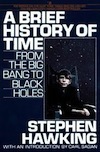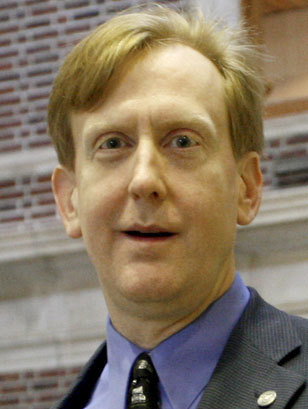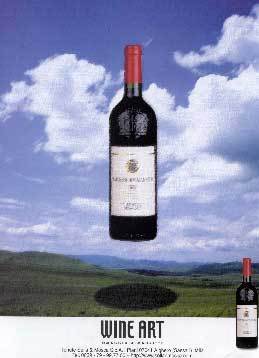Marc Abrahams's Blog, page 524
January 4, 2013
The Image of Those Who Make Medical Images
Radiologists, the professionals who create medical images, upon whose skill, care, and truthfulness we all rely, are a colorful bunch of people. A recent letter/diatribe in a medical journal hints at just how colorful and bright some of them can be:
“Avoiding Testocracy,” Richard B. Gunderman, MD [pictured here], PhD, Zachary Ballenger, MD and , MD, Radiology, vol. 265, November 2012, pp. 332-335. (Thanks to investigator Ivan Oransky for bringing this to our attention.) The authors, at Indiana University School of Medicine, write:
“Recent controversy involving the American Board of Radiology (ABR) has garnered a great deal of attention. Allegations concerning widespread cheating on qualifying examinations, against which the ABR has mounted a spirited defense, have surfaced in national news media (2). In particular, critics allege that recently tested ABR candidates have been engaged in inappropriately sharing examination content with future candidates, artificially raising scores (3). Partly in response to these allegations, the ABR is requiring candidates, program directors, program coordinators, and department chairs to sign attestations prohibiting cheating, including the sharing of questions from examinations.
“One sign of a robust profession is the quality of dialogue surrounding its methods for educating and certifying the performance of new entrants. In what follows, we do not intend in any way to criticize or undermine the important work of the ABR or its personnel, trustees, and many volunteers. We seek only to stimulate…”

January 3, 2013
An fMRI study of surrealistic advertising
First, a quick look at (some of) the scientific works which have investigated how fMRI might help in the understanding of the human brain’s responses to Surrealism.
[1] Matching reality in the arts: self-referential neural processing of naturalistic compared to surrealistic images. (Perception. 2012;41(5):569-76.) (surrealistic pictures here)
[2]The Neural Basis of Object-Context Relationships on Aesthetic Judgment PLoS ONE 3(11): e3754 (surrealistic pictures here)
Intriguing though they may be, the studies don’t have much to say about how surrealism might interface with the commercial money-making real-world – say, via advertising. But just such an investigation has been performed by Dr. Mohamed M. Mostafa, associate professor of marketing at the Gulf University for Science and Technology (GUST) (Kuwait).In his paper entitled The persistence of memory: an fMRI investigation of the brain processing of Surrealistic imagery in advertising (Journal of Marketing Communications, 2012, DOI: 10.1080 /13527266.2011. 653688) the professor alerts us to the perils of ‘Blobology’
“Without testing theoretically driven marketing concepts, there is a chance of falling ‘unwittingly prey to exactly the kind of blobological approach that has received criticism in social and general neuroscientific circles’ (Lee and Chamberlain 2007, 23).”
The experiments, which showed surrealistic ads (like the one above) to observers in an fMRI machine, nevertheless bore fruit :
“Statistical analysis based on general linear model showed that, compared to other types of advertisements, Surrealistic imagery elicited greater activation in several brain areas including parietal cortex (BA 1, 2, 3, and 7), lateral parietal cortex (BA 39/40),
prefrontal cortex (BA 6/9), IFG (BA 45/46), ACC (BA 24), insula (BA 13) and amygdala.”
Notes:
• The Wine Art image used in the study (shown above) is provided courtesy of the Computing in the Humanities and Social Sciences department at the University of Toronto.
• The 2012 Ig Nobel NEUROSCIENCE PRIZE was shared by Craig Bennett, Abigail Baird, Michael Miller, and George Wolford [USA], for demonstrating that brain researchers, by using complicated instruments and simple statistics, can see meaningful brain activity anywhere — even in a dead salmon.
Errata :
• The ‘Wine Art’ ad appears to show a bottle of Marchese Di Villamarina 1993 (Sella & Mosca) rather than a bottle of Grand Marnier, as the paper describes.
“ … in an advertisement labeled ‘Wine Art’, we see a large bottle of Grand Marnier floating above the floor with no visible support in a direct parody of Magritte’s 1961 painting ‘Le Château des Pyrénées’ (Castle in the Pyrenees).”
• ‘Le Château des Pyrénées’ was painted in 1959.
• Grand Marnier is a brandy.

January 2, 2013
How many tunes?
Ashley Hamer does some math to find out many different tunes could possibly be written, given how many notes there are on the music scale. She explains it in this 11-minute-line video, chock full of examples:
Thanks to investigator Jennifer Ouellette for bringing this to our attention.

January 1, 2013
Approaches to approaches to bears
If you choose to approach a bear, you also get to choose which way to go about your task. Here are three of the many ways.
1. Troy Hurtubise designed, personally tested, then used a purpose-built suit of armor. Hurtubise was later, in 1998, awarded an Ig Nobel Prize in the field of safety engineering.
2. Anthony Victor Saunders and Adam Warwick Bell invented and patented what they call a “pop-up device for deterring an attacking animal”.
3. The unnamed person in this video used a flute. (Thanks to investigator Bruce Petschek for bringing it to our attention.)
BONUS: It’s always worth another look back at Troy Hurtubise in action:
SPECIAL BONUS: Troy eats ants:

December 31, 2012
Improved Method for Tracking Apocryphal Animals
Apocryphal animals are notoriously difficult to tag and track. This new study tells of a technological advance that could make a difference:
“Indirect Tracking of Drop Bears Using GNSS Technology“,” Volker Janssen [pictured here], Australian Geographer, Volume 43, Issue 4, December 2012. (Thanks to investigator Tom Gill for bringing this to our attention.) The author, at the University of Tasmania, explains:
“The use of Global Navigation Satellite System (GNSS) technology has been responsible for significant advances in [animal tagging and tracking] by providing the ability to obtain accurate, regular and frequent estimates of the changing distributions of many rare animal species. Employing conventional GNSS-based animal tracking methods to study drop bears is extremely difficult due to their habitat. The dense tree canopy regularly causes extended periods of complete GNSS signal loss, and sensors are often damaged during attacks on prey. This paper proposes an indirect, GNSS-based method for tracking drop bears. This involves tracking the prey rather than the predator in order to map the population of drop bears in a particular area. The method can be used to effectively estimate the number of drop bears in the study area. Analysis of the collected data provides valuable insights into the hunting behaviour of drop bears and has implications for a better understanding of the geographical distribution of other rare species, including hoop snakes and bunyips.”

The House of the Rising Sun, electronically
The orchestrator of this performance writes:
While following on the coat tail of my first popular video “Queen Bohemian Rhapsody Old School Computer Remix” I tried to change the venue and built a couple of robot bands (yeah! machines that play actual instruments). These videos didn’t fair as well so i decided to go back to the basics and create another video utilizing old computer equipment. For this video i recorded each instrument separately with a decent stereo mic and i also used a mixer to adjust the audio levels. i would like to point out that absolutely no sampling or audio effects were used.
Instruments:
a. HP Scanjet 3P, Adaptec SCSI card and a computer powered by Ubuntu v9.10 OS as the Vocals. (hey, the scanner is old)
b. Atari 800XL with an EiCO Oscilloscope as the Organ
c. Texas instrument Ti-99/4A with a Tektronix Oscilloscope as the Guitar
d. Hard-drive powered by a PiC16F84A microcontroller as the bass drum and cymbal
I was very pleased how the hard-drive drums turned out and they sound great.

December 30, 2012
2012 Yearly Golfball Patents: A look back
Over the course of the last year Improbable has attempted to address the question of whether the number of new patents for golfballs might or might not be used as a continuous gauge for human ingenuity. With the recent publication of December’s figures, The full results are now in. 
Statistics :
Highest monthly level : 11 golfball patents
Lowest monthly level : 2 golfball patents
Yearly total : 98 golfball patents
Arithmetic mean (per month) : 8.17 (approx.) golfball patents
Median : 8 (monthly) : golfball patents
Mode : 7 (monthly) : golfball patents
Rate per day : (bearing in mind that 2012 was a leapyear) : 0.2678 (approx.)
Days per golfball : 1 new golfball patent every 3.7347 days (approx.)
Questions :
[1] Is the rate likely to increase or decrease?
• • • • Based on the need for new golfball designs.
• • • • Countered by the increasing difficulties in perfecting such a (relatively) simple device.
• • • • Observing the facilitating effects of technological progress.
• • • • Standing on the shoulders of previous inventors.
[2] Are there a finite number of conceivable golfballs?
[3] With sufficient effort, might we oneday arrive at the best of all possible golfballs?
• • • • Or instead develop a branching taxonomy of gofballs?
[4] Drawing on post-constructural interpretations of materiality, can we meaningfully contrast golfball epiphenomena manifested in transformational causal renderings of co-occurrent assemblages with the corresponding contextual modalities of their spatiotemporal articulated relatedness – or not?
Caution :
With regard to forward-looking statements: Historical data should not be taken as an indicator of future performance. The Golfball Index may go down as well as up.
Disclaimer :
While every reasonable effort has been made to ensure that the information provided is accurate(ish), no guarantees for the currency or accuracy of the information are made. Representations of data are provided ‘as-is’ without express or implied warranty of any kind, including but not limited to fitness for a particular purpose, or warranties regarding satisfactory quality, security, compatibility, security or accuracy.
Many thanks to all the resourceful golfball inventors across the globe, without whom none of this would have been possible.
Note: “Prediction is very difficult, especially if it’s about the future” Niels Bohr (1885-1962)

Hawking’s theory (of God’s mind) validated in Beverly Hills?
 Physicist Stephen Hawking boosted his fame and income by writing the following phrase at the end of his book A Brief History of Time: ”If we discover a complete theory, it would be the ultimate triumph of reason – for then we should know the mind of God.”
Physicist Stephen Hawking boosted his fame and income by writing the following phrase at the end of his book A Brief History of Time: ”If we discover a complete theory, it would be the ultimate triumph of reason – for then we should know the mind of God.”
Evidence suggests that a company in Beverly Hills, California has achieved this ultimate triumph of reason. The US Patent and Trademark Office registered a trademark for the phrase “FIND GOD’S MATCH FOR YOU”. The record suggests that the company has been knowing the mind of God since at least 2010:
Word Mark
FIND GOD’S MATCH FOR YOU
Goods and Services
IC 045. US 100 101. G & S: Providing on-line personal introductions through a website, accessed via interconnected global computer networks, for the purpose of making acquaintances, friendship, and long term relationships. FIRST USE: 20100701. FIRST USE IN COMMERCE: 20100701
Registration Number
4083834
Registration Date
January 10, 2012
Owner
(REGISTRANT) Spark Networks USA, LLC LIMITED LIABILITY COMPANY DELAWARE Suite 800 8383 Wilshire Blvd. Beverly Hills CALIFORNIA 90211
If you wish to know the mind of God, consult the company.

A Bosch painting as a metaphor for theoretical physics
The In The Dark blog presents a metaphor for modern theoretical physics:
[This is] the painting that I often use to introduce cosmology talks. I usually use this piece of Hieronymus Bosch Das letzte Gericht (The Last Judgement) to illustrate my feelings about the standard cosmological model:

The top part represents the concordance cosmology. It clearly features an eminent cosmologist surrounded by postdoctoral researchers. Everything appears to be in heavenly harmony, surrounded by a radiant glow of self-satisfaction. The trumpets represent various forms of exaggerated press coverage.
But if you step back from it, and get the whole thing in a proper perspective, you realise that there’s an awful lot going on underneath that’s not so pleasant or easy to interptet. I don’t know what’s going down below there, although the unfortunate figures slaving away in miserable conditions and suffering unimaginable torments, are obviously supposed to represent graduate students. The large knife visible in the bottom right corner clearly symbolises budget cuts looming in the next Comprehensive Spending Review.
The main point is that the concordance model is based on rather strange foundations: nobody understands what the dark matter and dark energy are, for example….

Al Jazeera takes a quick look at the Ig Nobel Prizes
Marc Abrahams's Blog
- Marc Abrahams's profile
- 14 followers






